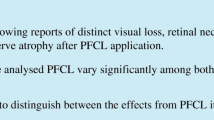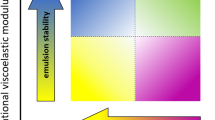Abstract
Background
Perfluorocarbon liquids (PFCL) are used extensively in complex vitreoretinal surgery, sometimes before the placement of silicone oil (SiO). We suspected that PFCL and SiO interact physically when in opposition, potentially making their removal more difficult. The nature of some of these interactions was explored using a mass spectrometric approach in in-vitro and in-vivo samples.
Methods
We incubated silicone oil (1,000 or 5,000 centistokes viscosity) and PFCL [perfluoro-n-octane (PFO) or perfluorotributylamine] together in vitro for 6 months and performed electron impact ionization mass spectrometry (EIMS) on the PFCL to characterize interactions between the liquid phases. Packaged samples of PFCL served as controls. We also examined in vivo samples of PFO which had been retained in human eyes for several months prior to surgical removal.
Results
Perfluorocarbon liquids packaged for surgical use all contain SiO in trace amounts, possibly as a manifestation of the processes used in their manufacture. Furthermore, all PFCLs incubated with SiO showed much more prominent contamination with SiO molecular fragments. PFCL was found in the SiO phase of eyes in which both liquids were present for extended periods of time. The EIMS analysis of in vivo samples suggested that proteins coat PFCL droplets, forming micelle-like structures.
Conclusion
Medical-grade PFCLs contain small amounts of SiO, and PFCLs dissolve small amounts of oil into solution over time. Interactions between retained vitreous substitutes may have clinical relevance.






Similar content being viewed by others
References
Bottoni F, Arpa P, Vinciguerra P, Zenoni S, De Molfetta V (1992) Combined silicone and fluorosilicone oil tamponade (double-filling) in the management of complicated retinal detachment. Ophthalmologica 204:77–81
Bourke RD, Simpson RN, Cooling RJ, Sparrow JR (1996) The stability of perfluoro-n-octane during vitreoretinal procedures. Arch Ophthalmol 114:537–544
Chang S (1987) Low-viscosity liquid fluorochemicals in vitreous surgery. Am J Ophthalmol 103:38–43
Chang S, Ozmert E, Zimmerman NJ, Fuchs W (1988) Intraoperative perfluorocarbon liquids in the management of proliferative vitreoretinopathy. Am J Ophthalmol 106:668–674
Chang S, Lincoff H, Zimmerman NJ, Fuchs W (1989) Giant retinal tears. Surgical techniques and results using perfluorocarbon liquids. Arch Ophthalmol 107:761–766
Friberg TR, Verstraeten TC, Wilcox DK (1991) Effects of emulsification, purity, and fluorination of silicone oil on human retinal pigment epithelial cells. Invest Ophthalmol Vis Sci 32:2030–2034
Geh VS, Dabbs TR, Ansari E (1997) Perfluorodecalin and silicone oil used to achieve retinal tamponade left in an eye for 6 months. Br J Ophthalmol 81(3)252–253
Hoerauf H, Kobuch K, Dresp J, Menz DH (2001) Combined use of partially fluorinated albanes, perfluorocarbon, and silicone oil: an experimental study. Graefes Arch Clin Exp Ophthalmol 239:373–381
Kertes PJ and Peyman GA (1997) Removal of a silicone-perfluorocarbon bubble. Can J Ophthalmol 32(7):446–447
Langefeld S, Kirchhof B, Meinert H, Roy T, Artez A, Schrage NF (1999) A new way of removing silicone oil from the surface of silicone intraocular lenses. Graefes Arch Clin Exp Ophthalmol 237:201–206
Laqua H, Luke K, Foerster MH (1987) Results of silicone oil surgery. Jpn J Ophthalmol 31:124–131
Lucke K, Foerster MH, Laqua H (1987) Long term results of vitrectomy and silicone oil in 500 cases of complicated retinal detachment. Am J Ophthalmol 104:624–633
McLafferty FW, Turecek F (1993) Interpretation of mass spectra. University Science Books, Mill Valley, California
Nakamura K, Refojo MF, Crabtree DV (1990) Factors contributing to the emulsification of intraocular silicone and fluorosilicone oils. Invest Ophthalmol Vis Sci 31:647–656
Nakamura K, Refojo MF, Crabtree DV, Leong FL (1990) Analysis and fractionation of silicone and fluorosilicone oils for intraocular use. Invest Ophthalmol Vis Sci 31:2059–2069
Nakamura K, Refojo MF, Crabtree DV, Pastor J, Leong FL (1991) Ocular toxicity of low molecular weight components of silicone and fluorosilicone oils. Invest Ophthalmol Vis Sci. 31:3007–3020
Peyman GA, Conway MD, Soike KF, Clark LC (1991) Long-term vitreous replacement in primates with intravitreal vitreon or vitreon plus silicone oil. Ophthalmic Surg 22:657–664
SleepTJ, Luff AJ (1999) In vivo formation of heavy oil. Retina 19(3):251–255
Sparrow JR, Ortiz R, Mac Leish PR, Chang S (1990) Fibroblast behavior at aqueous interfaces with perfluorocarbon, silicone, and fluorosilicone liquids. Invest Ophthalmol Vis Sci 31(4):638–646
Sparrow JR, Jayakumar A, Berrocal M, Ozmert E, Chang S (1992) Experimental studies of the combined use of vitreous substitutes of high and low specific gravity. Retina 12:134–140
Verstraeten TV, Williams GA, Chang S, Cox MS, Trese MT, Friberg TR (1995) Lens sparing vitrectomy with perfluorocarbon liquid for the primary treatment of giant retinal tears. Ophthalmology 102:17–20
Weinberger D, Goldenberg-Cohen N, Axer-Sieger R, Gaton DD, Yassur Y (1998) Long-term follow-up of perfluorocarbon liquid in the anterior chamber. Retina 18:233–237
Winter M, Winter C, Wiechens B (1999) Quantification of intraocular retained perfluorodecalin after macroscopic complete removal. Graefes Arch Clin Exp Ophthalmol 237:153–156
Acknowledgements
Nicole Shieler of Alcon Surgical, Fort Worth, Texas, graciously provided Perfluoron for our in-vitro investigations. The study was supported in part by the Eye and Ear Foundation, Pittsburgh, Pennsylvania.
Author information
Authors and Affiliations
Corresponding author
Additional information
Presented, in part, at the XXII Meeting of the Club Jules Gonin, Taormina, Sicily, 2000
The authors have no proprietary interest relevant to this study
Rights and permissions
About this article
Cite this article
Friberg, T.R., Siska, P.E., Somayajula, K. et al. Interactions of perfluorocarbon liquids and silicone oil as characterized by mass spectrometry. Graefe's Arch Clin Exp Ophthalmol 241, 809–815 (2003). https://doi.org/10.1007/s00417-003-0698-5
Received:
Revised:
Accepted:
Published:
Issue Date:
DOI: https://doi.org/10.1007/s00417-003-0698-5




